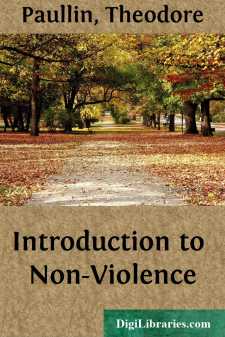Categories
- Antiques & Collectibles 13
- Architecture 36
- Art 48
- Bibles 22
- Biography & Autobiography 813
- Body, Mind & Spirit 142
- Business & Economics 28
- Children's Books 15
- Children's Fiction 12
- Computers 4
- Cooking 94
- Crafts & Hobbies 4
- Drama 346
- Education 46
- Family & Relationships 57
- Fiction 11828
- Games 19
- Gardening 17
- Health & Fitness 34
- History 1377
- House & Home 1
- Humor 147
- Juvenile Fiction 1873
- Juvenile Nonfiction 202
- Language Arts & Disciplines 88
- Law 16
- Literary Collections 686
- Literary Criticism 179
- Mathematics 13
- Medical 41
- Music 40
- Nature 179
- Non-Classifiable 1768
- Performing Arts 7
- Periodicals 1453
- Philosophy 64
- Photography 2
- Poetry 896
- Political Science 203
- Psychology 42
- Reference 154
- Religion 513
- Science 126
- Self-Help 84
- Social Science 81
- Sports & Recreation 34
- Study Aids 3
- Technology & Engineering 59
- Transportation 23
- Travel 463
- True Crime 29
Introduction to Non-Violence
by: Theodore Paullin
Categories:
Description:
Excerpt
I. INTRODUCTION: ON TERMS
"In the storm we found each other." "In the storm we clung together." These words are found in the opening paragraphs of "Hey! Yellowbacks!" The War Diary of a Conscientious Objector. Ernest L Meyer uses them to describe the psychological process by which a handful of men—a few professors and a lone student—at the University of Wisconsin grew into unity because they opposed the First World War, when everyone around them was being carried away in the enthusiasm which marked the first days of American participation. If there had been no storm, they might not have discovered their affinity, but as it was, despite the disparity of their interests and backgrounds, they found themselves in agreement on the most fundamental of their values, when all the rest chose to go another way. By standing together they all gained strength for the ordeals through which each must go, and they were filled with the spirit of others before them and far removed from them, who had understood life in the same way.
The incident may be taken as symbolic of the experience through which pacifists have gone in this Second World War, too. Men and women of many creeds, of diverse economic backgrounds, of greatly divergent philosophies, with wide variations in education, have come together in the desire to sustain one another and aid one another in making their protest against war. Each in his own way has refused to participate in the mass destruction of human life which war involves, and by that refusal has been united by the strongest bonds of sympathy with those of his fellows who have done likewise. But it is the storm that has brought unity. When the skies clear, there will be a memory of fellowship together, but there will also be a realization that in the half light we have seen only one aspect of each other's being, and that there are enormous differences between us. Our future hope of achieving the type of world we want will demand a continuation of our sense of unity, despite our diversities.
At present pacifism is no completely integrated philosophy of life. Most of us would be hard pressed to define the term "pacifist" itself. Despite the fact that according to the Latin origins of the word it means "peace maker," it is small wonder that our non-pacifist friends think of the pacifist as a negative obstructionist, because until the time came to make a negative protest against the evil of war we ourselves all too often forgot that we were pacifists. In other times, if we have been peace-makers at all, we have thought of ourselves merely as doing the duty of citizens, and, in attempting to overcome some of the causes of conflict both within our domestic society and in the relations between nations, we have willingly merged ourselves with other men of goodwill whose aims and practices were almost identical to ours.
Since the charge of negativism strikes home, many pacifists defend themselves by insisting that they stand primarily for a positive program, of which war-resistance is only a pre-requisite. They oppose war because it is evil in itself, but they oppose it also because the type of human brotherhood for which they stand can be realized only when war is eliminated from the world. Their real aim is the creation of the new society—long and imperfect though that process of creation may be. They share a vision, but they are still groping for the means of moving forward towards its achievement. They are generally convinced that some means are inappropriate to their ends, and that to use such means would automatically defeat them; but they are less certain about the means which will bring some measure of success.
One section of the pacifist movement believes that it has discovered a solution to the problem in what it calls "non-violent direct action." This group derives much of its inspiration from Gandhi and his non-violent movement for Indian independence. For instance, the Fellowship of Reconciliation has a committee on non-violent direct action which concerns itself with applying the techniques of the Gandhi movement to the solution of pressing social issues which are likely to cause conflict within our own society, especially discrimination against racial minorities....


